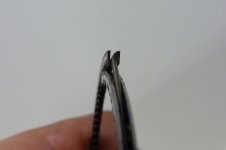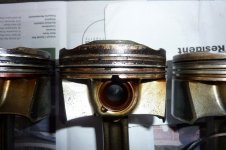I bought a 2nd hand engine to replace the cooked one in the 2013 BMW F20 18i that I bought as a non-runner. Now I know we are talking about French cars on this forum but given that the N13B16A engine is a derivative of the PSA EP6 series I beg your indulgence. The original engine was leaking coolant and had a softened (~70 Brinell) head that was warped 0.013”. It also had corrosion in the connection for the coolant level sensor and a brittle O-ring in the coolant sensor that is invisible at the back of the motor, that I think explained its demise.
My replacement engine had an uncertain past although it was claimed to have covered only 65,000 km. I removed the head and fortunately it was straight and hard (>100 Brinell) but it showed signs of battering possibly from a broken spark plug, and scratches indicated that the head had been off before. And it was unlikely to have been a low mileage car. I then removed one piston to check the ring gap and found that the 2 compression rings were well outside the upper limit (~30-35 cf 8-20 thou). I don't normally bother to check the oil rings but this had a one-piece oil ring with a coil spring sitting in its groove, so it was easy to check. This was where things became a bit weird- there was no gap when I placed it in the bore. In fact it was distorted indicating that it was bigger than the bore.
I then dug out the old pistons I had from fixing a Peugeot 207 VTi and it had the same type of oil rings. And they were oversize! The Haynes manual gives a gap of 12-20 thou.
What am I missing?
My replacement engine had an uncertain past although it was claimed to have covered only 65,000 km. I removed the head and fortunately it was straight and hard (>100 Brinell) but it showed signs of battering possibly from a broken spark plug, and scratches indicated that the head had been off before. And it was unlikely to have been a low mileage car. I then removed one piston to check the ring gap and found that the 2 compression rings were well outside the upper limit (~30-35 cf 8-20 thou). I don't normally bother to check the oil rings but this had a one-piece oil ring with a coil spring sitting in its groove, so it was easy to check. This was where things became a bit weird- there was no gap when I placed it in the bore. In fact it was distorted indicating that it was bigger than the bore.
I then dug out the old pistons I had from fixing a Peugeot 207 VTi and it had the same type of oil rings. And they were oversize! The Haynes manual gives a gap of 12-20 thou.
What am I missing?


